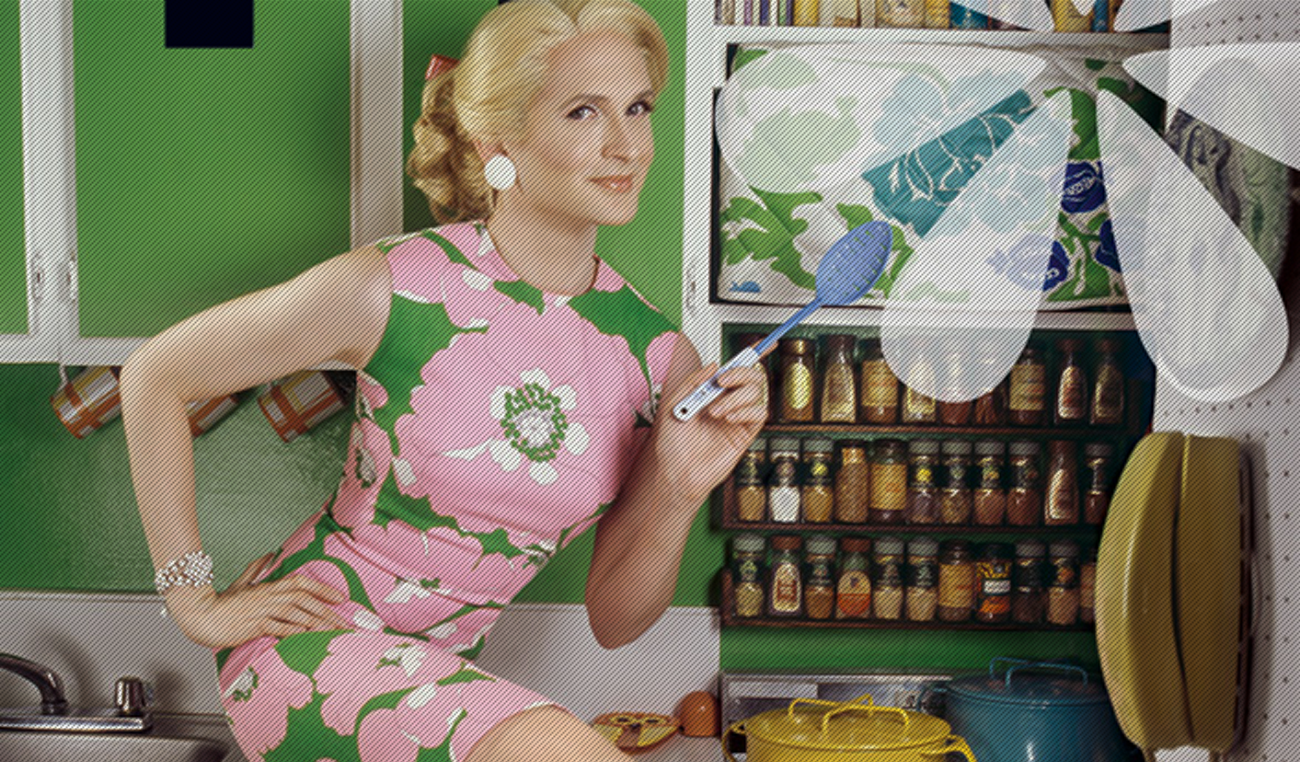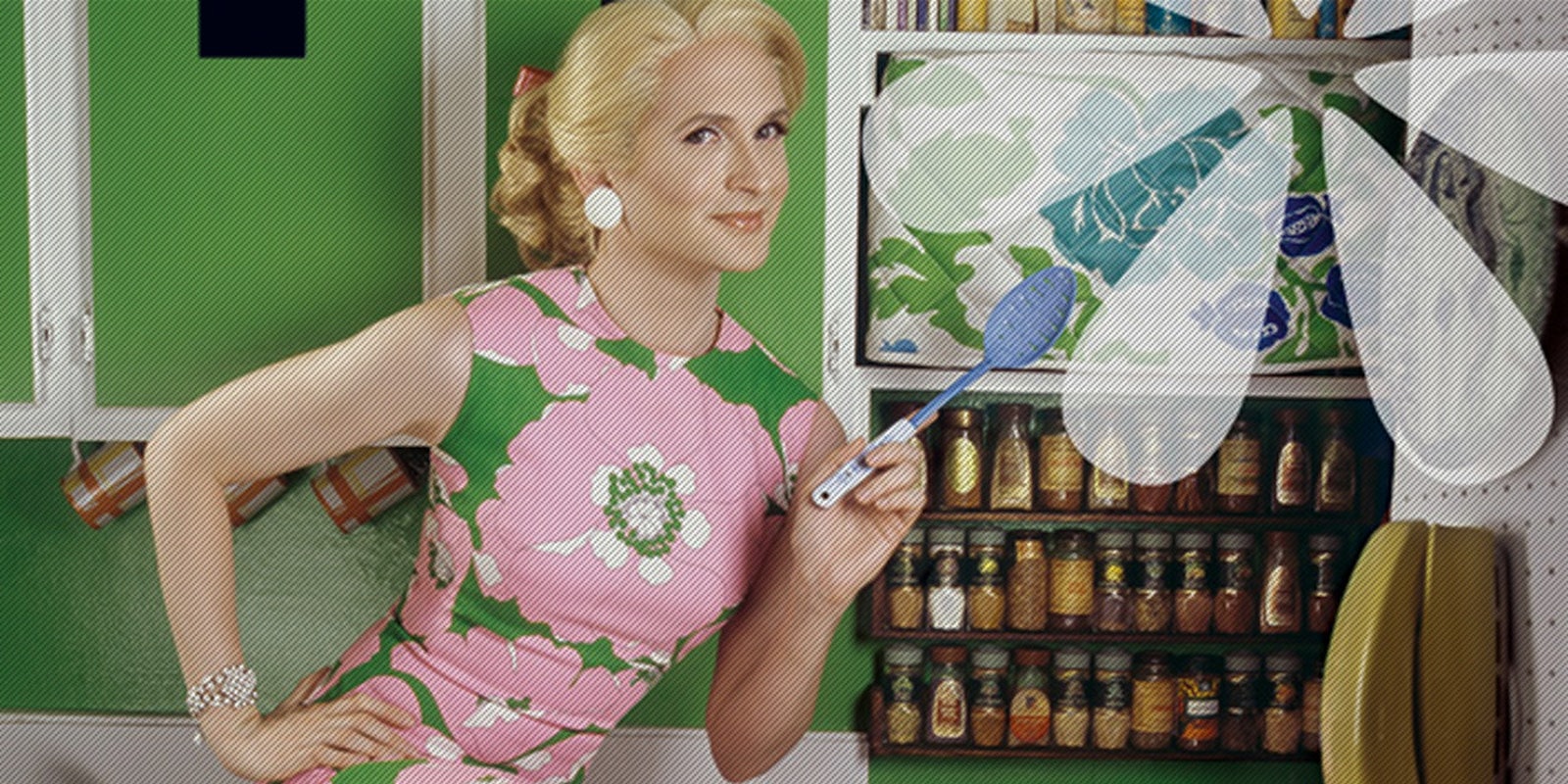Brini Maxwell is showing me how to fold a pair of slacks. In her YouTube segment, The Maxwell Moment, she’s demonstrating how to properly hang up a pair of trousers—not pants, she explains with a polite titter, “because in England, pants means, well, unmentionables”—without creasing them. A cool blonde in a cream-colored sheath and a colorful Pucci imitation scarf, she has the soft-spoken, mid-Atlantic-infused timbre of a 1940s MGM contract star and the composure of a Milhouse-dazed, Eisenhower-era housewife.
“Its very important when you’re hanging up a pair of trousers that you don’t close the front closure before putting it on the hanger,” she says.
If I watched a video of anyone else teaching me how to fold pants, I’d be bored to tears. But when Maxwell folds pants (sorry, trousers), mundane household tasks become almost glamorous.
 Described as the love child of Martha Stewart and 1950s sitcom star Donna Reed, Brini Maxwell is a retro-inspired domestic goddess whose YouTube channel is a library of household how-tos: how to fold a napkin, how to practice hot tub etiquette, how to finish an antique wall unit, how to make the perfect Old Fashioned. (She also has a line of home design products, Felix Populi, including pillows, linens, bath products, and DIY crafting kits.)
Described as the love child of Martha Stewart and 1950s sitcom star Donna Reed, Brini Maxwell is a retro-inspired domestic goddess whose YouTube channel is a library of household how-tos: how to fold a napkin, how to practice hot tub etiquette, how to finish an antique wall unit, how to make the perfect Old Fashioned. (She also has a line of home design products, Felix Populi, including pillows, linens, bath products, and DIY crafting kits.)
Earlier this month, Brini released an ebook, Have A Ball With Brini (part of a series called Here’s How by Brini Maxwell), that advises readers on how to make the perfect spherical foods for entertaining guests.
Today, there are literally millions of YouTube channels, Etsy vendors, and Pinterest users embracing the DIY crafting trend, teaching you how to do everything from fold napkins to making earrings out of bedazzled tampons. Yet Brini Maxwell, in many ways, precedes them all: Since 1996, she’s been taping her home and lifestyle show, The Brini Maxwell Show, which later aired on the Style Channel for two seasons.
Created and performed by Ben Sander, an FIT grad with a passion for all things mid-century modern, The Brini Maxwell Show aired on public access cable television—which he says was “the YouTube of its day”—during the mid to late ’90s. The character was inspired by Sander’s love for all things midcentury modern, as well as his parents, a theatrical professor and an actress who threw glamorous faculty parties when Sander was growing up in the Midwest.
“It’s that sense of midcentury graciousness, that style of entertaining that has fallen out of favor with a large portion of the population, that’s looked at with nostalgia these days,” Sander says of the inspiration behind Brini.
Originally conceived as a jet-setting woman of the world called “Tigs van der Veer,” Brini Maxwell came about by combining the first name of a character from a 1980s Stefanie Powers TV movie with the last name of Barbra Streisand’s role in Sander’s favorite movie, What’s Up, Doc? The pilot, a segment on how to make Swedish meatballs, was produced in 1996. It also marked the first appearance of Maxwell’s hapless sidekick, Mary Ellen, played by New York City drag legend Thom “Panzi” Hansen, whom Sander describes as a “proxy” for the American public.
“She’s the one who always asks, ‘Why are we doing this? Why aren’t we just throwing some crackers on a plate?’” Sander says. “It gives Brini the opportunity to explain there’s something nice about taking your time and making things happen in pretty ways.”
In its early days, The Brini Maxwell Show was shot in Sander’s retro Chelsea apartment (Sander’s mother helped direct), reflecting the unpolished, do-it-yourself aesthetic that’s currently seen on most YouTube channels. Yet the show was an instant hit, which Sander attributes in part to his platform on public access television.
“At the time, the content I was producing for public access was so far beyond what anyone else was putting out there. It immediately became a sensation because no one had seen anything like it,” he says. “So I didn’t really have to promote anything. It’s harder to do that on YouTube today. There’s so much content and so much of it is well-produced and some of it isn’t, but it’s a broader, bigger field and it’s harder to stand out.”
In 2004, the show was picked up by the Style Network, where it ran for two seasons. Sander then launched video and audio podcasts for the character, as well as a line of home design products. Sander, a lifelong crafter, also appeared in character to lead craft workshops nationwide—his passion for “taking raw material and turning them into something useful or pretty” aligning with the widespread popularization of online DIY craft culture a few years ago.
“I am really glad to see that crafting has become more popular, and the Internet is a great place to foster that kind of content because it’s something that’s searchable and people can really have interact with its creators,” Sander says. “I’ve always thought it was fun to incorporate that into the character, to capitalize on that aspect of homemaking. I don’t think I can take any credit for the explosion of the whole genre online, but I certainly took part in it.”
 Sander’s passion for midcentury modern, exemplified by the sleek, candy-colored, kitschy-classy aesthetic of Maxwell’s apartment and wardrobe (much of which consists of pieces Sander sewed himself), also preceded the trend of cultural nostalgia for the 1950s and 1960s, years before Mad Men, ModCloth, and Etsy vintage vendors popularized retro chic. Where the character may have seemed like a campy novelty or delightfully regressive blast from the past a few years ago, today Maxwell seems more in step with our nostalgia-crazy cultural milieu.
Sander’s passion for midcentury modern, exemplified by the sleek, candy-colored, kitschy-classy aesthetic of Maxwell’s apartment and wardrobe (much of which consists of pieces Sander sewed himself), also preceded the trend of cultural nostalgia for the 1950s and 1960s, years before Mad Men, ModCloth, and Etsy vintage vendors popularized retro chic. Where the character may have seemed like a campy novelty or delightfully regressive blast from the past a few years ago, today Maxwell seems more in step with our nostalgia-crazy cultural milieu.
For his part, Sander is pleased by the cultural tendency to nostalgize the recent past, or at least he understands the impulse to do so. “There’s a sense of appreciation for the glamour of that era in today’s sweatshirt and sweatpants way of going about our daily lives,” he says. “Travel was glamorous, people dressed up to go out to dinner. People liked the idea of caring about things and making choices that are about presenting yourself to other people in a positive light, and we’re certainly taking things in a different direction now.”
Yet Sander—and, by extension, his cool, elegant, long-stemmed alter ego—is keeping an eye toward the future as well. “Socially we’re moving forward with leaps and bounds,” says Sander, who was recently ordained to perform same-sex weddings and plans to devote his follow-up ebook to the subject.
“We’re in a place now where we can better appreciate the past. A lot of the things that I talk about and feature on the show, that were considered bourgeois and ordinary and mundane, now when you look at them in perspective with the time, they seem unique and exotic. I like that I can take those things and present them to a new audience.
“It’s that distance between then and now that makes them interesting.”
Photo via Brinimaxwell.com


